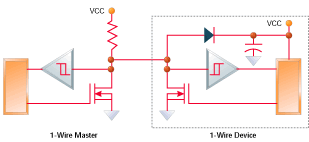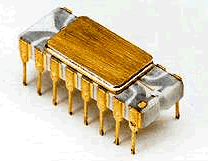~
(not) 1. res. The unary bitwise-NOT operator in C and various related languages. Sometimes confused with the logical NOT operator !, though their functions are very different. Make sure you use the right one; your compiler won't know to warn you of the error.
EXAMPLE: If 16-bit x is 0x0123, ~x is 0xFEDC; whereas !x is 0 (Boolean false).
2. symb. A prefix used on schematic diagrams and in logic equations to indicate active low signals.
µC/OS
(micro-kos) N. A real-time operating system for small microcontrollers. Derived from a two-part expository article in Embedded Systems Programming in May–June 1992, this little RTOS took on a life of its own with the publication of a book-length treatment of the subject by creator Jean Labrosse. Now in the operating system's second release (µC/OS-II), the revised book includes complete source code and explanations of everything it does. Micrium sells licenses for commercial use.
1-Wire
N. A low-cost bidirectional serial communications bus requiring just a single wire to implement. An asynchronous, half-duplex, single-master component bus, 1-Wire minimizes device pin count by using extra on-chip circuitry to enable each 1-Wire component to communicate serially (over a shared connection) with other 1-Wire devices. Compatible serial EEPROMs, A/D converters, temperature sensors, and other devices are available. Electrical features include low data rates (about 16 kbps, max), flexible voltage and timing requirements, long maxium distances (up to 1,000 feet), and optional parasitic powering of slaves. Each 1-Wire device has a unique 48-bit serial number, so multiple slaves can share the same bus. [more]
HISTORY: The 1-Wire protocol was invented by Dallas Semiconductor, which received a related patent prior to its merger with Maxim.

A representation of the circuitry used to connect 1-Wire devices.
1489
(fourteen eighty-nine) num. An obsolete chip used to receive RS-232 signals. A 1970s part originally from Motorola, the 1489 was a line receiver that translated the +/-15 V RS-232 levels to TTL signals. Now replaced by combined receiver/transmitter chips such as the MAX232 from Maxim.
4004
(four thousand four) num. The first microprocessor. Invented by Intel (a memory company at the time) in 1971, the 4004 was the world's first general-purpose microprocessor. A far cry from modern processors, the 4004 had a 12-bit instruction pointer, forty six 8-bit opcodes, and sixteen 4-bit registers. The 4004 was a 16-pin DIP part, containing about 2,000 transistors.

The world's first single-chip processor.
See also Busicom.
68xx
(sixty eight ex-ex) num. A family of 8- and 16-bit microcontrollers from Freescale (nee Motorola Semiconductor). Family members include the 68HC05, 68HC11, and 68HC12.
7-segment display
n. A device that displays all numbers and many letters and symbols via just seven linear segments. Most also have one or two decimal points. The LED version of an 7-segment display comes in both common anode and common cathode configurations, indicating whether each diode's anode or cathode is connected together. 7-segment LCD displays are also widely used. [more]
There's no standard for driving LEDs. Some designers drive them directly from the processor's GPIO pins, connecting each segment to an output pin. This uses more I/O pins but lets the programmer generate any of the possible characters. Others use a driver IC (e.g., 74HC4511), which accepts a 4-bit input, creates a character, amplifies the output, and drives the segments; these limit the possible characters that can be displayed.
To support multi-digit displays, most vendors supply banked 7-segment displays, in which the anodes or cathodes are brought ought individually to pins, and the other terminals--those connected to segments--are all tied together. This supports multiplexing of the display via dedicated hardware or smart software.
8-bit
1. adj. Generally used to denote a processor that uses a data bus 1 byte wide. Note that this always refers to the processor's data bus width. Typical 8-bit CPUs have 16 or 20 address lines.
2. adj. Any circuit or algorithm that operates on data 1-byte wide. Examples include 8-bit buffers and 8-bit D/A converters.
8051
(eighty fifty-one) num. An 8-bit microcontroller family. The original 8051 was designed in the late 1970s by Intel. Its many variants are still popular with embedded systems developers and are now available from multiple suppliers. Related chips include Siemens' 80C517, TI's TMS370, and the 80251.
8254
(eighty-two fifty-four) num. The programmable counter/timer chip used in the original IBM PC and still emulated to this day.
8N1
(as letters and numbers) abbr. A common flavor of serial communications that features 8 data bits, no parity, and 1 stop bit. Other specifications have the same format, with E and O indicating even and odd parity, respectively. This information is normally coupled with the number of data bits per second, such as 9600 bps or 57.6 kbps. For example, the specification "9600 8E1" means 9600bps serial communications with 8 data bits, 1 even parity bit, and 1 stop bit.
